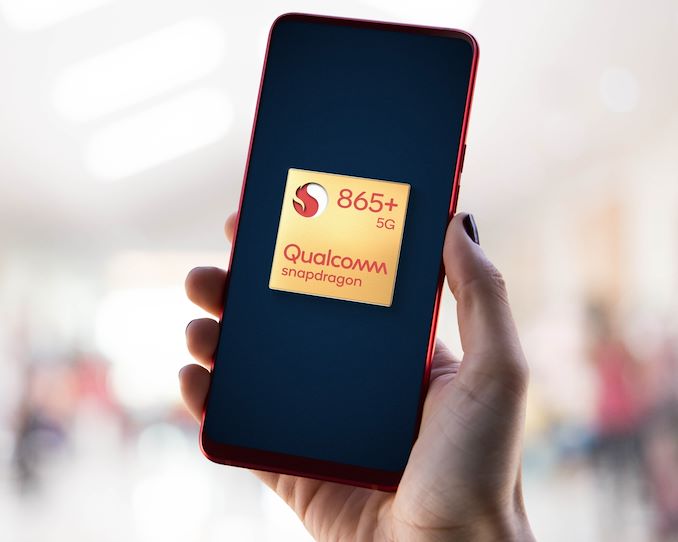Qualcomm Announces Snapdragon 865+: Breaking the 3GHz Threshold
by Andrei Frumusanu on July 8, 2020 9:30 AM EST- Posted in
- Mobile
- Qualcomm
- SoCs
- Snapdragon 865
- future-u

Today Qualcomm is announcing an update to its extremely successful Snapdragon 865 SoC: the new Snapdragon 865+. The Snapdragon 865 had already seen tremendous success with over 140 different design wins, powering some of the best Android smartphone devices this year. We’re past the hectic spring release cycle of devices, and much like last year with the S855+, for the summer and autumn release cycle, Qualcomm is providing vendors with the option for a higher-performance binned variant of the chip, the new S865+. As a bit of a arbitrary, but also important characteristic of the new chip is that this is the first ever mobile silicon to finally pass the 3GHz frequency mark.
| Qualcomm Snapdragon Flagship SoCs 2020 | |||
| SoC | Snapdragon 865 |
Snapdragon 865+ |
|
| CPU | 1x Cortex A77 @ 2.84GHz 1x512KB pL2 3x Cortex A77 @ 2.42GHz 3x256KB pL2 4x Cortex A55 @ 1.80GHz 4x128KB pL2 4MB sL3 @ ?MHz |
1x Cortex A77 @ 3.1GHz 1x512KB pL2 3x Cortex A77 @ 2.42GHz 3x256KB pL2 4x Cortex A55 @ 1.80GHz 4x128KB pL2 4MB sL3 @ ?MHz |
|
| GPU | Adreno 650 @ 587 MHz | Adreno 650 @ ? +10% Perf |
|
| DSP / NPU | Hexagon 698 15 TOPS AI (Total CPU+GPU+HVX+Tensor) |
||
| Memory Controller |
4x 16-bit CH @ 2133MHz LPDDR4X / 33.4GB/s or @ 2750MHz LPDDR5 / 44.0GB/s 3MB system level cache |
||
| ISP/Camera | Dual 14-bit Spectra 480 ISP 1x 200MP 64MP ZSL or 2x 25MP ZSL 4K video & 64MP burst capture |
||
| Encode/ Decode |
8K30 / 4K120 10-bit H.265 Dolby Vision, HDR10+, HDR10, HLG 720p960 infinite recording |
||
| Integrated Modem | none (Paired with external X55 only) (LTE Category 24/22) DL = 2500 Mbps 7x20MHz CA, 1024-QAM UL = 316 Mbps 3x20MHz CA, 256-QAM (5G NR Sub-6 + mmWave) DL = 7000 Mbps UL = 3000 Mbps |
||
| Mfc. Process | TSMC 7nm (N7P) |
||
We’ve come to know the Snapdragon 865 quite well over the last few months, detailing the performance of the chipset in our initial benchmark articles as well as a more extensive deep-dive in our Galaxy S20 review. The new Snapdragon 865+ is a new binned variant of the same chipset with higher peak frequencies on the part of the “prime” CPU as well as the GPU, promising +10% performance on both aspects.
The First Mobile Silicon to Break Past 3GHz – 3.1GHz Even
Whilst in relative terms the new chipset’s +10% clock improvement isn’t all that earth-shattering, in absolute terms it finally allows the new Snapdragon 865+ to be the first mobile SoC to break past the 3GHz threshold, slightly exceeding that mark at a peak 3.1GHz frequency. Ever since the Cortex-A75 generation we’ve seen Arm make claims about their CPU microarchitectures achieving such high clock frequencies – however in all those years actual silicon products by vendors never really managed to quite get that close in commercial mass-production designs.
We’ve had a chat with Qualcomm’s SVP and GM of mobile business Alex Katouzian, about how Qualcomm achieved this, and fundamentally it’s a combination of aggressive physical design of the product as well as improving manufacturing yields during the product’s lifecycle. Katouzian explained that they would have been able to achieve these frequencies on the vanilla Snapdragon 865 – but they would have had a lower quantity of products being able to meet this mark due to manufacturing variations. Yield improvements during the lifecycle of the Snapdragon 865 means that the company is able to offer this higher frequency variant now.
For context, in the mobile world, usually SoC SKUs are binned not by performance (clock-frequency), but by power (voltage variations). This comes in contrast to the desktop and server world where one single silicon design is binned by different performance SKUs, varying in frequencies or even functional blocks. In a sense, Qualcomm’s 855+ and 865+ are SKUs that expand the product line in the way that usual PC silicon vendors do. Other mobile vendors such as MediaTek for example also take advantage of such product segmentation by releasing a single silicon design as multiple product SKUs.
As to what this means for the power and efficiency of the new Snapdragon 865+: There will be a power increase to reach the higher frequencies, however this will only be linear with the increased clock speed, meaning energy efficiency of the new SoC will maintain the same excellent levels of that of the Snapdragon 865, so battery life will not be affected.
More + Designs This Year
This mid-year refresh was only introduced last year with the Snapdragon 855+, and while we’ve seen some vendors opt for the upgrade in their latest device releases, uptake was rather limited, with only a few handful more prominent devices such as the ASUS ROG Phone II.
This year, Qualcomm tells us that we should be expecting more adoption for the refreshed silicon, with more design wins. Amongst the publicly announced platforms today is naturally the AUSS ROG Phone 3, with full details on the phone to follow in the next couple of weeks. Lenovo is also part of the launch partners, promising to bring to market a smartphone under the Lenovo Legion branding.
Amongst other new novelties of the Snapdragon 865+ platform is the ability for vendors to bundle with the new FastConnect 6900 Wi-Fi chips from Qualcomm, the company’s new Wi-Fi 6 chipsets with 6GHz band capability (Wi-Fi 6E).
We’re looking forward to devices with the new Snapdragon 865+ in the coming weeks and months.
Related Reading:
- Qualcomm Announces Snapdragon 855 Plus: A Higher Bin SKU
- Qualcomm Announces Snapdragon 865 and 765(G): 5G For All in 2020, All The Details
- The Snapdragon 865 Performance Preview: Setting the Stage for Flagship Android 2020
- The Samsung Galaxy S20+, S20 Ultra Exynos & Snapdragon Review: Megalomania Devices
- The Snapdragon 855 Phone Roundup: Searching for the Best Implementations











81 Comments
View All Comments
Spunjji - Wednesday, July 8, 2020 - link
The eternal tedium of the monopoly market :|abufrejoval - Wednesday, July 8, 2020 - link
I'll admit it has become a bit boring, only having Apple chips not usable unless you're an iSlave or Qualcomm as 'best in a class of one'.But I can't say I am unhappy with what they deliver... only wish I could get a dev board for €99.
eastcoast_pete - Wednesday, July 8, 2020 - link
How are the new Mediatek chips in comparison? The "dimensity" 1000 (dumb name for an interesting SoC, IMO) has promising specs, and, thanks to Huawei's difficulties, is apparently made on 7 nm by TSMC. Don't know about their availability on devboards, though.BedfordTim - Thursday, July 9, 2020 - link
HiSilicon are up there with Qualcomm, but their HiKey boards are reassuringly expensive.29a - Friday, July 10, 2020 - link
Why are iPhone users iSlaves in your mind? My 4 year old iPhone still receives iOS updates how many 4 year old Android devices are getting updates to the latest version of Android? The last version of Android the Samsung Galaxy S7 supports is Android 8, which is two versions old.lmcd - Friday, July 10, 2020 - link
Sideloading doesn't exist and thus the FOSS scene and hobbyist scene absolutely suck.iphonebestgamephone - Saturday, July 11, 2020 - link
Sideloading is possible with jailbreak tho? Or even without it using a workaround.Socius - Friday, July 24, 2020 - link
Well that's just incorrect. You can easily setup sideloading even without jailbreaking using various methods. And if you are jailbroken, the iPhone jailbreak app customization scene is far more advanced than the android one. I have an android phone and tablet, as well as an iPhone. I definitely have more customization options on the iphone. Sure, the tweaks cost $$ unless you pirate them, but they're very cheap and well worth it, and is what allows the scene to flourish.sonny73n - Sunday, July 12, 2020 - link
Not just iSlaves, also iIdiots. Do you need updates? Did updates make your iPhones better? Do you have choices regarding which OS version you want to have (compared to Android)? Do you have an option to downgrade? Do you feel superior for paying 3 to 4 times more than the actual manufacturing cost of an iPhone?... The list goes on but iIdiots would never understand.Socius - Friday, July 24, 2020 - link
Manufacturing cost of a product has absolutely nothing to do with its retail price. The most costly part of any product is R&D and marketing. You don't think the top Android manufacturers also charge several times more than the cost of production?